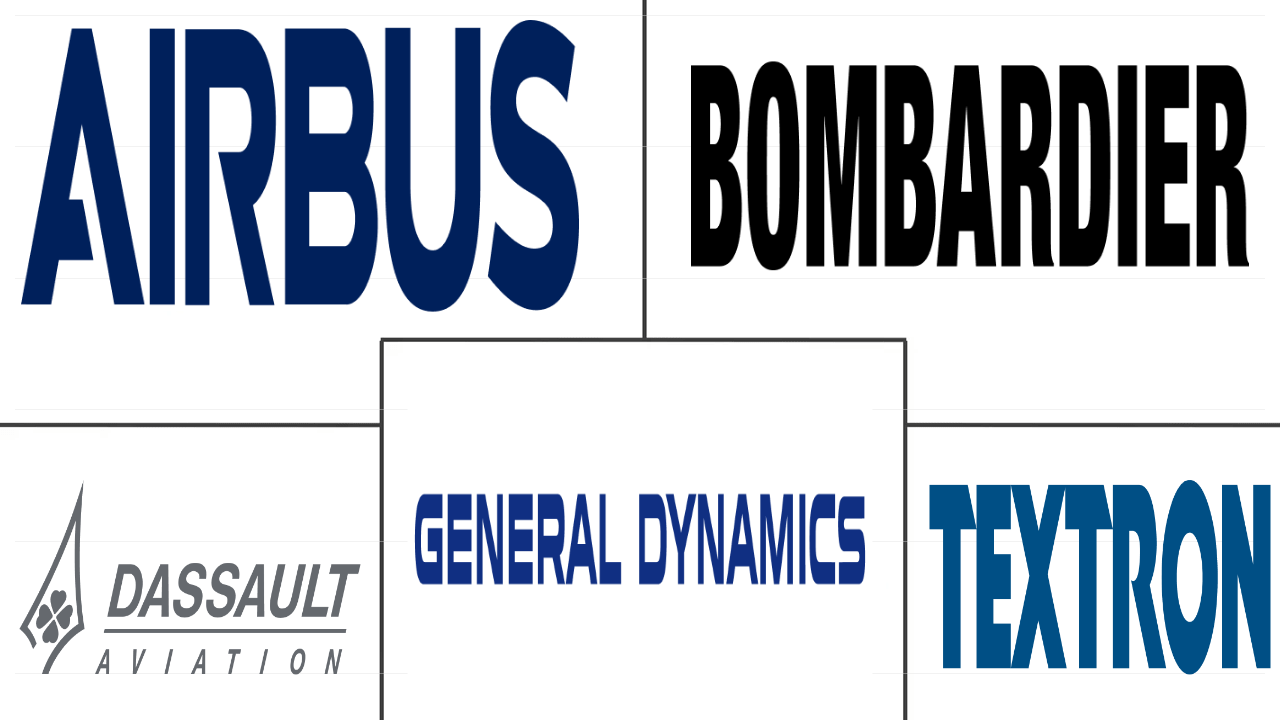Market Size of asia-pacific business jet Industry
|
|
Study Period | 2017 - 2030 |
|
|
Market Size (2024) | USD 1.59 Billion |
|
|
Market Size (2030) | USD 2.37 Billion |
|
|
Largest Share by Body Type | Large Jet |
|
|
CAGR (2024 - 2030) | 6.91 % |
|
|
Largest Share by Country | China |
Major Players |
||

|
||
|
*Disclaimer: Major Players sorted in no particular order |
Asia-Pacific Business Jet Market Analysis
The Asia-Pacific Business Jet Market size is estimated at 1.59 billion USD in 2024, and is expected to reach 2.37 billion USD by 2030, growing at a CAGR of 6.91% during the forecast period (2024-2030).
1.6 B
Market Size in 2024 (USD)
2.4 B
Market Size in 2030 (USD)
290
Total Deliveries in the Historic Period (2017-2023)
325
Total Deliveries during the Forecast Period (2024-2030)
Largest Market by Body Type
90.56 %
value share, Large Jet, 2023
The increasing popularity of large jets because of their comfort, convenience, and ability to travel long distances is projected to drive their demand in the region.
Largest Market by Country
22.61 %
value share, China, 2023
As the country's economy is recovering, companies and wealthy individuals in China have sharply increased their use of private jets, thereby prompting an upward shift in business travel.
Leading Market Player
41.16 %
market share, General Dynamics Corporation, 2022

The company's focus on new product development in various types of business jet segments is boosting its position as a leading player.
Second Leading Market Player
20.58 %
market share, Bombardier Inc., 2022

The company's strongest and most advanced fleet of different types of business jets is encouraging customers to procure more jets, resulting in a high market share.
Third Leading Market Player
16.46 %
market share, Dassault Aviation, 2022

The company offers a wide array of business jets to most countries in the region, which is driving it to be one of the leading players.
The large jet segment is the most prominent, as many business jets are classified as charter, private, or corporate jets
- Business jets are private jets designed to carry small groups of people. They can be used for various other roles as well. As of July 2022, business jets in Asia-Pacific accounted for 6% of the active global fleet. Out of these, the large jet segment accounted for a major market share of 52%, followed by 22% for light jets and 17% for mid-size jets.
- The large jet segment dominates as many business jets fall into charter, private, or corporate use. The UHNWIs are the major users who value these jets primarily due to their range, technology, cabin size, and efficiency. Some of the most delivered jets are Gulfstream G500/550/650/650ER, Global 6000/7500 Express, Challenger 604/605/650, and Dassault Aviation SA's Falcon series.
- During the study period, Cessna (a subsidiary of Textron Inc.) was the major OEM for deliveries in the light jet segment, with 21 jets. Bombardier was the major OEM in the mid-size segment with six jets, followed by Gulfstream Aerospace Corporation, a wholly-owned subsidiary of General Dynamics, with six jets. Gulfstream Aerospace Corporation is a major OEM in the large jet segment, with 97 jets, followed by Bombardier with 45 jets.
- Gulfstream Aerospace Corporation, Bombardier, and Cessna dominate the business jet market, accounting for 60% of the total new business jet deliveries between 2017 and 2022. Out of the total operational business jets in Asia-Pacific, 98% are wholly owned, while the remaining are shared and fractional ownership.
The private aviation industry has experienced a significant boost in demand due to the robust economic recovery in South Asia
- During the COVID-19 pandemic, the reduction in economic activities in the region, along with travel-related restrictions, affected the demand for and utilization of business jets. However, post-pandemic, strong economic recovery and the removal of travel restrictions fueled the demand for private jets, especially in Southeast Asia. Foreign investments surged, especially in Singapore, Thailand, Cambodia, and Malaysia, which resulted in higher demand for private charters. Due to the large customer base, business jet OEMs are primarily targeting this region and are expecting high demand for new business jets over the next decade. In 2022, the region witnessed growth of -10 % compared to 2021.
- The HNWIs and UHNWIs prefer private jets for personal or business travel. The rise in the number of HNWI individuals in the Asia-Pacific region aided in the procurement of new business jets. Compared to 2017, the HNWI population in the region increased by 68% in 2022.
- In terms of the current operational fleet of 1,279 jets in Asia-Pacific, China accounts for 21%, followed by Australia, India, and Japan, with around 17%, 13%, and 9%, respectively. Cessna, Bombardier, and Gulfstream together account for 51% of the current operational business jet fleet in the region. In 2022, China, Australia, and Japan were the major countries in terms of new business jet deliveries.
- Over 362 new business jets are expected to be delivered in the region between 2023 and 2030. The economic recovery in the developing economies in the region, such as China and Southeast Asia, is expected to boost the growth of the business jet market during the forecast period.
Asia-Pacific Business Jet Industry Segmentation
Large Jet, Light Jet, Mid-Size Jet are covered as segments by Body Type. Australia, China, India, Indonesia, Japan, Malaysia, Philippines, Singapore, South Korea, Thailand are covered as segments by Country.
- Business jets are private jets designed to carry small groups of people. They can be used for various other roles as well. As of July 2022, business jets in Asia-Pacific accounted for 6% of the active global fleet. Out of these, the large jet segment accounted for a major market share of 52%, followed by 22% for light jets and 17% for mid-size jets.
- The large jet segment dominates as many business jets fall into charter, private, or corporate use. The UHNWIs are the major users who value these jets primarily due to their range, technology, cabin size, and efficiency. Some of the most delivered jets are Gulfstream G500/550/650/650ER, Global 6000/7500 Express, Challenger 604/605/650, and Dassault Aviation SA's Falcon series.
- During the study period, Cessna (a subsidiary of Textron Inc.) was the major OEM for deliveries in the light jet segment, with 21 jets. Bombardier was the major OEM in the mid-size segment with six jets, followed by Gulfstream Aerospace Corporation, a wholly-owned subsidiary of General Dynamics, with six jets. Gulfstream Aerospace Corporation is a major OEM in the large jet segment, with 97 jets, followed by Bombardier with 45 jets.
- Gulfstream Aerospace Corporation, Bombardier, and Cessna dominate the business jet market, accounting for 60% of the total new business jet deliveries between 2017 and 2022. Out of the total operational business jets in Asia-Pacific, 98% are wholly owned, while the remaining are shared and fractional ownership.
| Body Type | |
| Large Jet | |
| Light Jet | |
| Mid-Size Jet |
| Country | |
| Australia | |
| China | |
| India | |
| Indonesia | |
| Japan | |
| Malaysia | |
| Philippines | |
| Singapore | |
| South Korea | |
| Thailand | |
| Rest of Asia-Pacific |
Asia-Pacific Business Jet Market Size Summary
The Asia-Pacific business jet market is poised for significant growth, driven by the increasing demand from high-net-worth individuals (HNWIs) and ultra-high-net-worth individuals (UHNWIs) who prefer private jets for personal and business travel. The market is characterized by a strong presence of large jets, which dominate due to their range, technology, and efficiency, making them ideal for charter, private, and corporate use. The region's business jet fleet is largely owned outright, with a small portion under shared and fractional ownership. The market is fairly consolidated, with major players like Gulfstream Aerospace Corporation, Bombardier, and Cessna leading in new deliveries. The economic recovery post-COVID-19, particularly in Southeast Asia, has further fueled demand, with countries like China, Australia, and Japan being key players in new jet deliveries.
The market's expansion is supported by the rising number of HNWIs in the region, particularly in developing economies such as India, Vietnam, and Thailand, which have seen substantial growth in their HNWI populations. The Asia-Pacific region is emerging as a global hub for wealth management and private banking, driven by increasing wealth and the need for financial advisory services. The business jet market is expected to benefit from foreign investments and economic recovery, with a significant number of new jets anticipated to be delivered over the forecast period. The market's growth is also supported by strategic expansions and investments by major OEMs, enhancing their operational capabilities and offerings in the region.
Asia-Pacific Business Jet Market Size - Table of Contents
-
1. MARKET SEGMENTATION (includes market size in Value in USD and Volume, Forecasts up to 2030 and analysis of growth prospects)
-
1.1 Body Type
-
1.1.1 Large Jet
-
1.1.2 Light Jet
-
1.1.3 Mid-Size Jet
-
-
1.2 Country
-
1.2.1 Australia
-
1.2.2 China
-
1.2.3 India
-
1.2.4 Indonesia
-
1.2.5 Japan
-
1.2.6 Malaysia
-
1.2.7 Philippines
-
1.2.8 Singapore
-
1.2.9 South Korea
-
1.2.10 Thailand
-
1.2.11 Rest of Asia-Pacific
-
-
Asia-Pacific Business Jet Market Size FAQs
How big is the Asia-Pacific Business Jet Market?
The Asia-Pacific Business Jet Market size is expected to reach USD 1.59 billion in 2024 and grow at a CAGR of 6.91% to reach USD 2.37 billion by 2030.
What is the current Asia-Pacific Business Jet Market size?
In 2024, the Asia-Pacific Business Jet Market size is expected to reach USD 1.59 billion.

